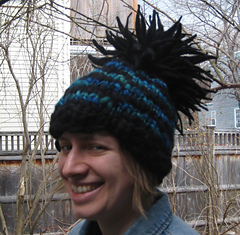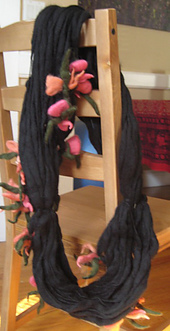
That matches that bedroom uncannily, you might be thinking. Uncanny it is not. That was Ryan (midwest-dwelling old friend and recipient of the quilt) and me going to the visit The Loopy Ewe's impressive wall of Cascade 220 like maniacs with the duvet, a throw pillow, and paint chips.
At the Missouri Botanical Garden Ryan bought this book about natural dyeing. It's really great because it's organized by seasons and is more focused on what you can harvest in the wild than what you'd cultivate in a garden (with the exception of a few biggie non-US native dyes like indigo and madder.)
We decided to try harvesting some dyestuffs, and pretty quickly gave up on the idea of finding plants given our location and season. Instead we gathered a bunch of fungi, lichens, and some old walnuts from last year.

We went to Knitorious, a fabulous yarn store in St. Louis, to buy some Cascade Eco Wool and one skein of Lopi on deep discount. Searching for alum as a mordant led us to Penzey's Spices, a completely lovely spice store that did not have alum but did have some other dyestuffs, namely turmeric and dried sumac berries. We bought some of those for good measure, naturally. Alum was later located at a supermarket.
I made mini skeins out of the Eco Wool. Here they are alongside some delicious pies Ryan made while I was skeining.

We first tried our hand with the turmeric, since it was pretty much a sure thing. Just look at the dye bath!

Indeed, it makes yellow yarn. The lopi was in this batch too.

Next, we decided to try the lichens and shelf fungi together, for funsies. Ryan, a true scientist, figured we needed to maximize surface area by blending the goods.

We cooked that up for a while, strained it, and added one test skein.

Ryan was afraid what we had made was just "dinge," but we soldiered on with the cooking of the yarn. Ryan added vinegar, you know, for science. Between the turmeric and the vinegar, it was smelling pretty pickly up in his kitchen.
We let the yarn soak overnight, and in the morning I was quite convinced the yarn was a color other than dingy. Yellowish even. Hard to tell in this iPhone photo, though.

I left Ryan with more skeins, plus the sumac and walnuts. I hope he tries them! In any case, I think we had enough fun that I've won him over on the idea of hosting my dye garden and perhaps even some livestock...
One last photo of skeins drying in the basement. Ryan sent this to me today; could that fungus-dyed yarn really be greenish or is there just a ghoulish pallor in his basement? Who knows?
















